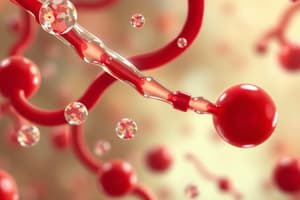Podcast
Questions and Answers
What is a significant reason that heparin should not be administered orally?
What is a significant reason that heparin should not be administered orally?
- Heparin is a negatively charged particle that is not absorbed. (correct)
- Heparin is rapidly metabolized in the gastrointestinal tract.
- Heparin is poorly absorbed orally due to high molecular weight.
- Heparin requires a specific pH level for absorption.
Which side effect is associated with heparin administration?
Which side effect is associated with heparin administration?
- Localized bleeding at the injection site. (correct)
- Increased risk of thrombosis.
- Liver failure.
- Bone density loss.
What is the primary mechanism by which heparin prevents coagulation?
What is the primary mechanism by which heparin prevents coagulation?
- Activating clotting factors.
- Increasing the production of fibrinogen.
- Binding to antithrombin and accelerating protease inhibition. (correct)
- Inhibiting platelet aggregation.
How is heparin therapy monitored?
How is heparin therapy monitored?
Which statement accurately describes heparin's interaction with antithrombin?
Which statement accurately describes heparin's interaction with antithrombin?
Which route of administration is appropriate for heparin?
Which route of administration is appropriate for heparin?
What is a potential misconception about the use of heparin?
What is a potential misconception about the use of heparin?
Which of the following is NOT a characteristic of heparin?
Which of the following is NOT a characteristic of heparin?
What effect does warfarin have on the synthesis of coagulation factors?
What effect does warfarin have on the synthesis of coagulation factors?
Why is there a delayed effect of warfarin therapy, taking 18-24 hours to exhibit its anticoagulant action?
Why is there a delayed effect of warfarin therapy, taking 18-24 hours to exhibit its anticoagulant action?
What is the primary method to monitor the effectiveness of warfarin therapy?
What is the primary method to monitor the effectiveness of warfarin therapy?
Which enzyme is inhibited by therapeutic doses of warfarin, affecting vitamin K metabolism?
Which enzyme is inhibited by therapeutic doses of warfarin, affecting vitamin K metabolism?
Which component is crucial for the synthesis of biologically competent proteins affected by warfarin?
Which component is crucial for the synthesis of biologically competent proteins affected by warfarin?
What reversal agent is commonly used in emergency situations to counteract warfarin's effects?
What reversal agent is commonly used in emergency situations to counteract warfarin's effects?
What is the half-life of warfarin, informing its pharmacokinetics?
What is the half-life of warfarin, informing its pharmacokinetics?
How does high-dose vitamin K reverse the effects of warfarin?
How does high-dose vitamin K reverse the effects of warfarin?
Which of the following anticoagulants is a low molecular weight heparin (LMWH)?
Which of the following anticoagulants is a low molecular weight heparin (LMWH)?
What is a characteristic of low molecular weight heparins that distinguishes them from unfractionated heparin?
What is a characteristic of low molecular weight heparins that distinguishes them from unfractionated heparin?
What is the primary mechanism of action of Warfarin?
What is the primary mechanism of action of Warfarin?
Which of the following is NOT a characteristic of low molecular weight heparins?
Which of the following is NOT a characteristic of low molecular weight heparins?
Which is true regarding Fondaparinux?
Which is true regarding Fondaparinux?
Which of the following anticoagulants requires monitoring via aPTT?
Which of the following anticoagulants requires monitoring via aPTT?
What is an important side effect associated with Warfarin use?
What is an important side effect associated with Warfarin use?
Which coagulation factors are affected by Warfarin's mechanism of action?
Which coagulation factors are affected by Warfarin's mechanism of action?
What is a significant laboratory consideration when using LMWH?
What is a significant laboratory consideration when using LMWH?
Which anticoagulant is derived from spoiled clover feed and was initially used as rat poison?
Which anticoagulant is derived from spoiled clover feed and was initially used as rat poison?
Which of the following factors is NOT synthesized in the liver and requires vitamin K for activation?
Which of the following factors is NOT synthesized in the liver and requires vitamin K for activation?
What is the main reason why LMWHs offer a higher therapeutic index?
What is the main reason why LMWHs offer a higher therapeutic index?
Which protein's activation is essential for Warfarin's mechanism of action?
Which protein's activation is essential for Warfarin's mechanism of action?
Study Notes
Heparin
- Heparin is a highly negatively charged molecule and is therefore not absorbed orally or intramuscularly.
- Heparin is administered intravenously or subcutaneously.
- Heparin binds to antithrombin and accelerates its protease inhibition.
- Heparin induces a conformational change in antithrombin, which makes the reactive site more accessible to the protease.
- Heparin prevents the formation of fibrin, which prevents coagulation
- Heparin's effects are monitored by measuring the activated partial thromboplastin time (aPTT).
Low Molecular Weight Heparin (LMWH)
- LMWHs are fractionated heparins with a molecular weight of less than 8,000 daltons.
- LMWHs are used for the prevention and treatment of deep vein thrombosis (DVT).
- LMWHs inhibit factor Xa selectively.
- LMWHs do not prolong the aPTT.
- LMWHs have a higher therapeutic index than unfractionated heparin.
- LMWHs are administered subcutaneously.
- LMWHs have predictable pharmacokinetics, making dosing convenient.
- Common LMWHs include enoxaparin (Lovenox), dalteparin (Fragmin), and tinzaparin (Innohep).
Fondaparinux
- Fondaparinux is a synthetic pentasaccharide that selectively inhibits factor Xa.
- Fondaparinux is not sensitive to protamine.
Warfarin
- Warfarin was discovered serendipitously in the 1920s when spoiled clover was substituted for corn in cattle feeds.
- Warfarin was initially used as a rat poison.
- Warfarin is a common oral anticoagulant.
- Warfarin inhibits vitamin K epoxide reductase, which is essential for the synthesis of clotting factors.
- Warfarin inhibits the synthesis of coagulation factors II, VII, IX, and X.
- Warfarin has a delayed effect, taking 18-24 hours to reach its full effect.
- Warfarin is highly bound to plasma proteins, primarily albumin.
- Warfarin has a small volume of distribution and a half-life of 36 hours.
- Warfarin is metabolized by the liver.
- Warfarin's therapeutic index is narrow, and its effects are monitored by measuring the international normalized ratio (INR).
- Warfarin is usually started at a dose of 5-10 mg and is titrated to achieve the desired INR.
Warfarin Reversal
- Warfarin's effects are reversed using vitamin K (orally or intravenously) or plasma infusion.
- Menadiol sodium phosphate, a synthetic analogue of vitamin K, can also be used to reverse warfarin's effects.
Studying That Suits You
Use AI to generate personalized quizzes and flashcards to suit your learning preferences.
Related Documents
Description
Test your knowledge on heparin and low molecular weight heparin (LMWH). This quiz covers their mechanisms of action, administration routes, and clinical applications like DVT prevention and treatment. Understand the differences in monitoring and pharmacokinetics to enhance your pharmacology expertise.




